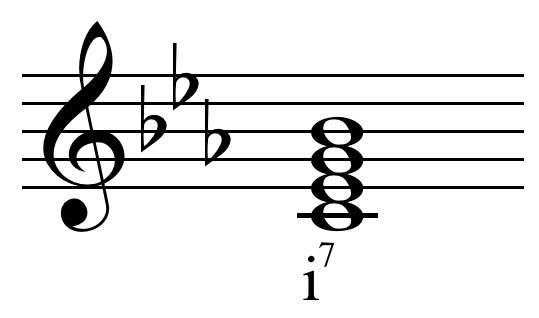 | ||
In music, a minor seventh chord is any nondominant seventh chord where the "third" note is a minor third above the root.
Contents
Most typically, minor seventh chord refers to where the "seventh" note is a minor seventh above the root (a fifth above the third note). This is more precisely known as a minor/minor seventh chord, and it can be represented as either as m7 or -7, or in integer notation, {0, 3, 7, 10}. In a natural minor scale, this chord is on the tonic, subdominant, and dominant degrees. In a harmonic minor scale, this chord is on the subdominant degrees. In an ascending melodic minor scale, this chord is on the supertonic degree. In a major scale, this chord is on the second (supertonic seventh), third (mediant) or sixth (submediant) degrees. For instance the ii7 in the ii-V-I turnaround.
Example of tonic minor seventh chords include LaBelle's "Lady Marmalade", Roberta Flack's "Killing Me Softly with His Song", The Doobie Brothers' "Long Train Runnin'", Chic's "Le Freak", and the Eagles' "One Of These Nights".
When the seventh note is a major seventh above the root, it is called a minor/major seventh chord. Its harmonic function is similar to that of a "normal" minor seventh, as is the minor seven flat five or half-diminished chord – but in each case, the altered tone (seventh or fifth, respectively) creates a different feeling which is exploited in modulations and to use leading-tones.
Minor seventh as virtual +6 chord
The minor seventh chord may also have its interval of minor seventh (between root and seventh degree, i.e.: { C B♭ } in { C E♭ G B♭ } ) rewritten as an augmented sixth { C E♭ G A♯ }. Rearranging and transposing, this gives { A♭ C♭ E♭ F♯ }, a virtual minor version of the German augmented sixth chord. Again like the typical +6, this enharmonic interpretation gives on a resolution irregular for the minor seventh but normal for the augmented sixth chord, where the 2 voices at the enharmonic major second converge to unison or diverge to octave.
Minor/minor seventh chord table
The just minor seventh chord is tuned in the ratios 10:12:15:18. Play This may be found on iii, vi, and vii. Another tuning may be in the ratios 48:40:32:27. Play
Chord Guide for Guitar
(Standard Tuning. Read left to right, so the low E is on the left, the high e is farthest to the right. The number corresponds to the fret.)
Minor 7 Chords
Am7: x02010
Bm7: x20202
Cm7: xx1313
Dm7: xx0211
Em7: 020000
Fm7: 131111
Gm7: xx3333
The Fm7 is a moveable chord shape. So, if you move it to 24222, it becomes F#m7. Remember that between BC and EF there are no sharps or flats when you do this.
